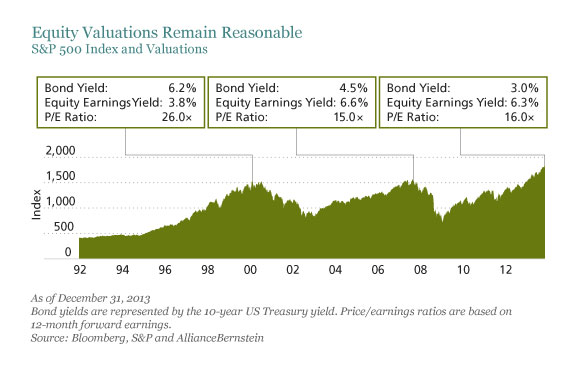After another big year for stocks in 2013, many investors are questioning how much longer the bull market can run before it collapses from exhaustion. This doubt has intensified with the early 2014 selloff. However, based on what we see, it’s not time to worry about the market’s stamina yet.
The S&P 500 Index returned over 32% in 2013—that’s the fifth straight year of positive equity-market returns and the best year since 1997. As the market chalked up these strong gains, earnings per share grew by about 6%. So, there was a significant increase in the price/earnings (P/E) ratio—the amount the market pays for a dollar of S&P 500 earnings.
How much room is there for P/E multiples to expand, paving the way for further gains? Some investors aren’t convinced that they’ll expand at all—they seem more worried that multiples could head in the other direction if interest rates rise. Proponents of this view point to the modest market correction when Chairman Ben Bernanke mentioned tapering at the May Fed meeting. The pain was acute in interest-rate-sensitive sectors, including those linked to housing.
But we think they’re discounting the powerful new market highs in the last few months of 2013 against a backdrop of rising rates, stronger economic data and the actual onset of Fed tapering. Despite talk about a “bubbly” market, the P/E multiple for the S&P 500 was about 16 times at year-end. While that’s higher than it was two or three years ago, it still reveals stock valuations to be modest—and dramatically lower than the prior market peak in 2000 (Display). Earnings yields are also more attractive versus bond yields than in earlier periods.  In our view, if interest rates rise gradually and economic growth accelerates (as we expect), the powerful bull market isn’t likely to lose steam yet. What’s driving our positive outlook?
In our view, if interest rates rise gradually and economic growth accelerates (as we expect), the powerful bull market isn’t likely to lose steam yet. What’s driving our positive outlook?
Relative valuations: Even after five consecutive up years and big gains, stocks are still cheaper than average compared with bonds—even factoring in somewhat higher interest rates.
Equity demand: Given our view on the relative attractiveness of stocks and the fact that many institutional and individual investors remain underweight equities, we tend to think cash flows will favor stocks. Firms are also aggressively buying back their outstanding shares, further driving demand.
Wealth and deleveraging: We’re a long way from the financial crisis. Household net worth and free cash flow are at record levels. Consumer debt is reasonable with very low servicing costs. The banking system is benefiting from modest credit costs and brimming with excess capital.
An accelerating economy isn’t required for stocks to do well, but we do see an acceleration—one that could provide a boost. The market’s early tumble in 2014 raised concerns about fundamentals—in this case, perceived instability in emerging markets and somewhat weaker data in the US. We don’t think the issues in emerging markets undermine the attractiveness of US stocks—and we don’t believe that US data trends indicate slowing growth.
We think stronger consumers and housing will be among the drivers of improved growth. This suggests opportunities in economically sensitive stocks—particularly issues in the financials, consumer discretionary and industrials sectors with more reasonable valuations. We think caution is warranted in more defensive areas like utilities and consumer staples.
Of course, there are certain factors that—if they intensify—could call for more caution toward equities. Inflation pressures could increase, though we don’t see this happening any time soon. The federal budget situation could strengthen over the next few years, but we’re in uncharted waters as federal debt approaches $18 trillion and long-term structural issues remain. Also, if rates rise more rapidly than in our projected multiyear baseline assumption, it could sap the market’s strength.
While these potential risks undoubtedly bear watching, our overall assessment is that the equity bull still has room to further stretch its legs.
The views expressed herein do not constitute research, investment advice or trade recommendations and do not necessarily represent the views of all AllianceBernstein portfolio-management teams.